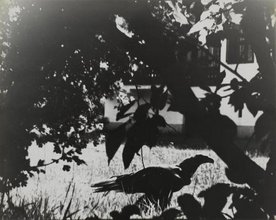Exhibition / Museum
Avec qui venez-vous au Musée ?
Who are you coming to the Museum with?
20 Mar - 27 Jun 2022

The event is over

Annette Messager, « L’ombre dessinée sur le mur » © Adagp, Paris, 2022 © Centre Pompidou, MNAM-CCI/Philippe Migeat/Dist. RMN-GP
In collaboration with Vinciane Despret, philosopher and guest intellectual at the Centre Pompidou in 2021-2022, the Museum is presenting three rooms dedicated to new forms of attention to the living. These exhibitions are part of the "Who Are You Coming With?" programme the philosopher has designed for the Centre Pompidou this year.

Annette Messager, « L’ombre dessinée sur le mur » © Adagp, Paris, 2022 © Centre Pompidou, MNAM-CCI/Philippe Migeat/Dist. RMN-GP
Saved from the Living
Room 2, Level 4
Vinciane Despret seeks to rethink our role in the environments that sustain us, which we inhabit and share with other living beings. From this perspective, this room seeks to underline one of the paradoxes inherent in the fundamental mission of museums: while the living is the subject of multiple representations testifying to these forms of attention and are sometimes even an integral part of the creative process - such as with David Koloane’s Mystery Box (1990-1999) containing various animal fragments – at the same time, for the conservation of the works placed in its care, museums have to fight or even eliminate all living beings that can “infest” the works during their transport or exhibition (insects, fungi, bacteria etc.). Various preventive conservation operations, such as anoxia, which consists of placing a work of art in an oxygen-free environment for several weeks, make it possible to save - albeit only temporarily - works of art from the living. But is this not another characteristic of many works, revealed and affirmed by all this effort to protect them: the fragility of their existence in relation to other beings?
Nicolas Liucci-Goutnikov, Curator, Head of Department of the Kandinsky Library. Musée National d'Art Moderne.
Passionate Ornithology
Rooms 5 and 7, Level 4
Like the question of territory raised by philosopher Vinciane Despret, the new alliances between humans and animals are intimately linked with the experiments carried out on the living by artistic creation.
In the early 1970s, Annette Messager trod on a dead sparrow on a pavement in Paris. Her practice based on rituals formed a miniature theatre of the human condition. By adopting the bird and others of its kind after their death, she plays with the unique ambivalence inherent to mothering: between tenderness and aggression. Around the same time, the ceremonial and secular practices of care also underpinned the sculptural and filmic approach of Nancy Graves. Initially developed in drawings, the sequences of her film Aves show the choreographed flight of flamingos and frigatebirds that translates, through the cinematographic framing, a dual interdependence: the flight of the bird defines the structure of the work, just as the animal and its environment are each constructed by the other. Magical animality also informed the mythological thinking of the CoBRA movement. For Danish artist Carl-Henning Pedersen, the bird or horse were, like the sun or the moon, a means of transcending the self. Works of art that capture a little of this animal power also convey all the ecological fragility of our bonds.
When
11am - 9pm, every days except tuesdays













